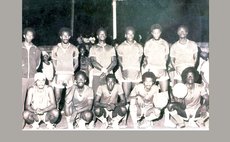Basketball's Evolution
JUMP BALL No. 86(Part IV) Modified by Arlington James

Part III of the article presented on the evolution of the following aspects of the game of basketball: out-of-bounds, mid-court line, three seconds/restricted area a.k.a. "the key", and the centre jump. The article concludes below.
Goal Tending: In 1944 the goaltending rule was adopted making it illegal for a defensive player to touch the ball on its downward flight. This was in reaction to American Bob Kurland (the first regular dunker) and George Mikan standing in front of the basket and swatting practically every opponent's shot attempt.
Offensive Basket Interference: In 1958 offensive basket interference was enacted. Mainly as a result of NBA's Bill Russell, who became known as the "Funneler" by using two hands to guide his teammates' shots into the basket. Note: In international basketball, once the ball strikes the rim offensive basket interference and goaltending rules do not apply.
Dunking - "Alcindor" Rule: From 1967 to 1977, a no dunking rule was enacted in college basketball. The reasons given were to prevent basket damage and injuries. However, it was specifically aimed at stopping Lew Alcindor [of the Los Angeles Laker's fame]. Unable to dunk, Alcindor developed his unstoppable "Sky Hook."
Game Coaching: In 1949 coaching during games was officially allowed. Prior to this time, believe it or not, no coaching was allowed during the game or even during a timeout. However, coaching was allowed during halftime.
Women's Basketball: Women's basketball was introduced in 1893 by Sendra Berenson, a gymnastic instructor, at Smith College, Northampton, Massachusetts. No male spectators were allowed since it was socially unacceptable at the time. What some say was a result of a misinterpretation of Naismith's court diagram led to three zone-sections with two players stationary in each section. In 1938, the three court sections (similar to netball) were reduced to two, with two stationary guards, two stationary forwards, and two "rovers" that could move around the entire court.
The first intercollegiate women's game was played between Stanford [University] and [University of] California in 1896. The first known interscholastic women's high school game was played in Illinois that same year. In 1971 women were finally allowed to play full court. The first-ever women's national championship was conducted by the Amateur Athletic Union (AAU) in 1936. FIBA held the first Women's World Championship in 1969 and Louisiana Tech won the first NCAA championship in 1982. In 1995, Oklahoma was the last state to switch from court sections to full-court play in high school games.
Perhaps the most important event to occur in women's basketball, as well as all women's sports, was the enactment of Title IX in 1972, equalizing men's and women's sports. Today, women's basketball is played with the same enthusiasm and intensity as men's basketball.
Comments: The above and three previous sections of the article collectively presented several aspects of the game of basketball at NBA, US College, Women's basketball, and FIBA (international) levels.
Modern players and spectators of the game take many aspects of basketball for granted. But changes have been made to the laws and reviewed all along to present a very entertaining sport to players and the sporting public.
We have seen the game 'develop' from playing with a soccer ball to having separately sized basketballs for men, women, and even junior players. The game's team size shrunk from a "Sa ki tapé'y" melée or just 'wash your foot and come', to an organized, 5-player team format with multiple substitutions allowed. We also saw in the case of free throws where initially any player on the team could shoot the free throw when assigned. In today's game if the wrong player shoots the 'foul shot' this constitutes an infraction. We also saw the concept of what constituted a foul change drastically.
Some of the rules that existed back then may seem ridiculous, if not ludicrous to today's readers. But, these were the laws that governed the game at the time.
Even in FIBA basketball, there was a time in the 1980s when a player who was fouled in the act of shooting and missed the shot would be awarded three (3) free throws to score two. If he scored the first two shots, the game would continue after the second shot. If he missed the first shot he still had a chance of scoring the second and third shots. Players on the local scene loved the opportunity but that did not make much of a difference in the conversion rate which was already frighteningly low (approximately 50% in Division I and progressively declining in the Intermediate and Junior Divisions).
I trust that readers enjoyed the opportunity of becoming more enlightened about the evolution of the game that we all love so much. Basketball!




